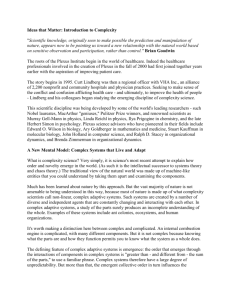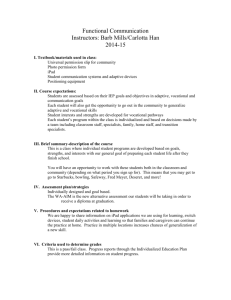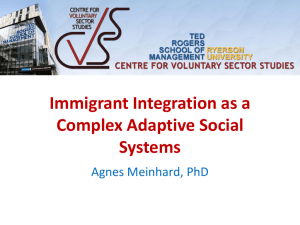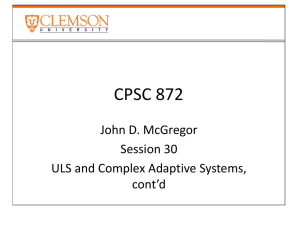Understanding Complexity and Innovation in Business Systems with
advertisement
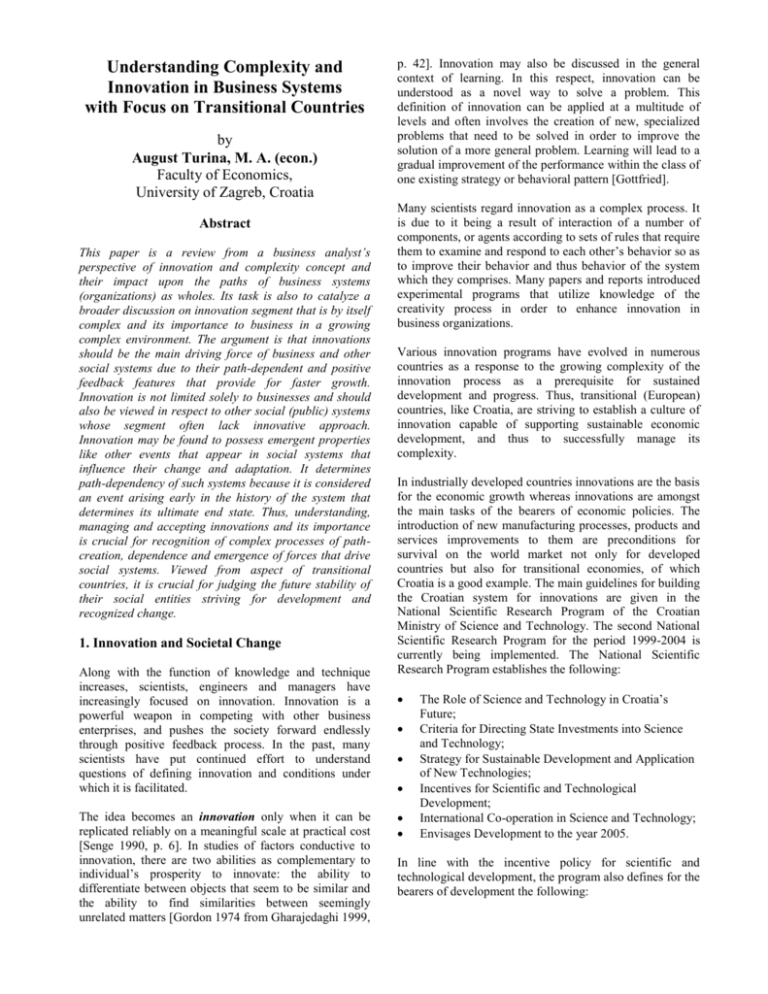
Understanding Complexity and Innovation in Business Systems with Focus on Transitional Countries by August Turina, M. A. (econ.) Faculty of Economics, University of Zagreb, Croatia Abstract This paper is a review from a business analyst’s perspective of innovation and complexity concept and their impact upon the paths of business systems (organizations) as wholes. Its task is also to catalyze a broader discussion on innovation segment that is by itself complex and its importance to business in a growing complex environment. The argument is that innovations should be the main driving force of business and other social systems due to their path-dependent and positive feedback features that provide for faster growth. Innovation is not limited solely to businesses and should also be viewed in respect to other social (public) systems whose segment often lack innovative approach. Innovation may be found to possess emergent properties like other events that appear in social systems that influence their change and adaptation. It determines path-dependency of such systems because it is considered an event arising early in the history of the system that determines its ultimate end state. Thus, understanding, managing and accepting innovations and its importance is crucial for recognition of complex processes of pathcreation, dependence and emergence of forces that drive social systems. Viewed from aspect of transitional countries, it is crucial for judging the future stability of their social entities striving for development and recognized change. 1. Innovation and Societal Change Along with the function of knowledge and technique increases, scientists, engineers and managers have increasingly focused on innovation. Innovation is a powerful weapon in competing with other business enterprises, and pushes the society forward endlessly through positive feedback process. In the past, many scientists have put continued effort to understand questions of defining innovation and conditions under which it is facilitated. The idea becomes an innovation only when it can be replicated reliably on a meaningful scale at practical cost [Senge 1990, p. 6]. In studies of factors conductive to innovation, there are two abilities as complementary to individual’s prosperity to innovate: the ability to differentiate between objects that seem to be similar and the ability to find similarities between seemingly unrelated matters [Gordon 1974 from Gharajedaghi 1999, p. 42]. Innovation may also be discussed in the general context of learning. In this respect, innovation can be understood as a novel way to solve a problem. This definition of innovation can be applied at a multitude of levels and often involves the creation of new, specialized problems that need to be solved in order to improve the solution of a more general problem. Learning will lead to a gradual improvement of the performance within the class of one existing strategy or behavioral pattern [Gottfried]. Many scientists regard innovation as a complex process. It is due to it being a result of interaction of a number of components, or agents according to sets of rules that require them to examine and respond to each other’s behavior so as to improve their behavior and thus behavior of the system which they comprises. Many papers and reports introduced experimental programs that utilize knowledge of the creativity process in order to enhance innovation in business organizations. Various innovation programs have evolved in numerous countries as a response to the growing complexity of the innovation process as a prerequisite for sustained development and progress. Thus, transitional (European) countries, like Croatia, are striving to establish a culture of innovation capable of supporting sustainable economic development, and thus to successfully manage its complexity. In industrially developed countries innovations are the basis for the economic growth whereas innovations are amongst the main tasks of the bearers of economic policies. The introduction of new manufacturing processes, products and services improvements to them are preconditions for survival on the world market not only for developed countries but also for transitional economies, of which Croatia is a good example. The main guidelines for building the Croatian system for innovations are given in the National Scientific Research Program of the Croatian Ministry of Science and Technology. The second National Scientific Research Program for the period 1999-2004 is currently being implemented. The National Scientific Research Program establishes the following: The Role of Science and Technology in Croatia’s Future; Criteria for Directing State Investments into Science and Technology; Strategy for Sustainable Development and Application of New Technologies; Incentives for Scientific and Technological Development; International Co-operation in Science and Technology; Envisages Development to the year 2005. In line with the incentive policy for scientific and technological development, the program also defines for the bearers of development the following: Business or Economic Sector; Higher Education Sector; Public Scientific-Research Institutions; and, Private Non-profit Institutions. The program also envisages the construction of a National network of Technology Centers with six basic forms of institutions, namely: Business Innovation Centers (that operate separately from Universities, however, in close co-operation with them); Centers for Transfer of Technology; Financial Institutions; Institutions for Forecasting and Supervision; Innovation and Engineering Associations; Other Centers for Technological Excellence; What such programs tend to neglect is the innovation in public administration segment. Furthermore, innovators and innovations in any aspect of social systems are forced to face, in the very process of transfer of knowledge, the very limits of public administration that suppress the very drive for change in any social system because they often lack innovative incentives themselves. Therefore, increasingly, the real innovation dilemma is not only the emergence of new knowledge and ideas but also their feasibility in an environment surrounded by administrational and bureaucratic complexity and complicatedness that suppress the idea of innovation of others in its own backyard. All too often, well-intentional efforts to solve pressing problems lead to policy resistance, where our policies are delayed, diluted, or defeated by the unforeseen reactions of other people or nature. Many times our best efforts to solve a problem actually make it worse [Sterman 2000, p. 3]. Also, many companies, especially small and mediumsized enterprises, those emerging in the transitional societies, are simply overwhelmed, and experience information overload. Having access to the right information at the right time is a key factor in a company’s ability to integrate change successfully. Managing information overload, social acceptance of new technologies, environmental concerns, and the basic logistics of introducing change often pose a far greater challenge to businesses than the (emergence of) underlying technologies themselves. Transitional countries should essentially be focused on building innovation support infrastructures especially in public service domain, and on the promotion of specific transfers of technology. They need to look more carefully at the global context in which innovations take place - at the management of the obstacles and risks imposed by external (administrational) or organizational (internal) factors. There is typically little innovation in bureaucracies. The main issue of transitional countries is still a costly, non-innovative and inefficient public administration that slows the progress of innovative organizations. But this goes beyond economic considerations. Technological development is essential for economic growth, but the innovative dynamics that is necessary to make it sustainable must also integrate considerations of social justice and environmental protection. Social awareness is what often lacks in transitional countries overwhelmed by bureaucracies and administration constraints. They often operate in favor of interest of individuals employed by public domain who often act to promote their private speculative interests rather than public ones. Or, they simply exist to justify their own existence and budget spending. The responsibility exercised by enterprises (and other publicly/socially significant institutions) towards their employees, customers and partners, and towards society in their city or region, makes innovation acceptable. Thus a framework for sharing of knowledge can be created, not only on the scientific content of technology transfer, but also on its relationship with the socio-economic and environmental context. It seems clear that this helps all stakeholders to assume greater responsibility, contributing to the growth of a distinctive innovation culture in transitional countries. There have always been inadequacies of prevailing ways of managing private and public sectors. Entrepreneurial organizations, however, reward the spontaneous generation of new knowledge that adds value, and allow their members considerable freedom to innovate [Wood 2000, p. 119]. Private companies have been building new types of organization – decentralized, nonhierarchical ones – dedicated to the well-being and growth of employees as well as success. Some had crafted radical corporate philosophies based on core values of freedom and responsibility. Others had developed innovative organization design. All shared a commitment and capacity to innovate that was lacking in the public sector. Why business is the focus of innovation in an open society? Business has a freedom to experiment missing in the public sector and, often, in nonprofit organizations. It also has a clear “bottom line”, so that experiments can be evaluated, at least in principle, by objective criteria [Senge 1990, p. 15]. 2. Innovation and Economic Evolution The importance of sharing knowledge, and the need to find solutions based on co-operation and consensus, are becoming increasingly evident. The very concept of sustainable development and development itself in transitional countries, a key factor in the pursuit of longterm economic and social progress, is based on the principle of consensus building. Innovation’s success increasingly relies also on non-technological factors, and businesses are gradually acknowledging the benefits of integrating all the stakeholders in the innovation process. Small and medium- size companies, too, could benefit from greater awareness of the growing importance of social and environmental factors in ensuring long-term competitiveness. The economy is an adaptive evolving system comprising of multiple agents diverse in abilities and capabilities, interacting, adapting, reacting and constantly modifying the patterns and structures that they help create. It primarily includes private profit-driven and public administration sectors but is not limited to. And, they do so on the basis of sets of internal rules that are modified and refined in the process of interaction. It is believed that this approach offers new opportunities for the modeling of adaptive processes. Therefore, first, it is imperative to stress that enterprise is the primary driver of modern capitalist trade economies. To treat enterprise seriously requires the tools and methods of an adaptive, evolutionary approach to economic growth. And, second, it is important to depict innovation as an emergent phenomenon that drives economic growth through positive feedback in which the focus is on the creation of patterns through interaction, with these patterns being created at different levels of interaction. It is suggested that it is transformation that enables growth and that the process of economic transformation is an evolutionary process. This process is driven by behavior of innovative agents (often employees aware of importance of learning and adaptive organization), process of selection that transforms diversity into pattern of change and process of development that generates and regenerates that behavioral variation. It is the manner of interdependence between these three elements that defines any particular process of economic transformation. Economic transformation has qualitative and quantitative dimensions and the interaction between the two is central to the evolutionary endeavor. The primary dynamic element in economic transformation is the generation of new business conjectures, theories and models of profitable activity that are to be tested in the market place. It raises questions of how creative the product or service is, or, what properties does it have as an experimental (novel) system? 3. Diversity, Innovation, Complexity and Adaptive Strategies Diversity is the integral to complexity. Accessing or creating new knowledge, decoupling from existing knowledge, and/or reconfiguring knowledge normally accomplish the innovation of complex technologies. Innovation occurs in two ways, with the creation of new trajectories and through innovation along those trajectories. In most cases, commercial success comes with innovation along trajectories [Kash, Rycroft]. Over the past decade a new approach to science, called complexity, has been addressing various kinds of paradoxes in natural systems. Complexity refers to the condition of the universe, which is integrated and yet too rich and varied for us to understand in simple common mechanistic or linear ways. We can understand many parts of the universe in these ways but the larger and more intricately related phenomena can only be understood by principles and patterns – not in detail. Complexity deals with nature of emergence, innovation, learning and adaptation [Santa Fe Group 1996, from Battram 2001, p. 12] What has been learned has useful implications and tools for businesses. The concepts that the scientists concern themselves with have a familiar ring in business: Adaptation, evolution and co-evolution, fitness, interactions of agents, the nature of environments, and the dynamic environment in which such systems adapt or die. We can extend the scientists’ understanding of how natural adaptive systems function in comparison to businesses and their unique problems. In that sense our knowledge of adaptive and emergent phenomena in ecosystems is powerfully suggestive about how businesses function. Businesses are more complex than ”natural” systems because of their explicit social and financial goals. Those goals are embodied in ideas. Ideas represent the cognitive frameworks and provide the coherence that allows creative, independent people to work toward common goals. The cognitive framework is the way to resolve the paradox of consistency and innovation. To manage and lead the business, one must understand that framework. When the framework is muddy, or interpreted in widely differing ways, the business is in trouble. And when a business is successful, it is so because a clear cognitive framework guides people as businesspersons. Businesses both conduct day-to-day operations and adapt continuously guided by that unifying framework. Today’s profits come from finely honed operations; tomorrow’s profits will come from innovations. The purpose of business strategy is to fuel innovation (new ideas and new benefit from them), and by that definition strategy must be adaptive and dynamic. The major challenge facing a business today is to create organizational environments in which adaptive strategies can emerge. The spread of rumors and new ideas, the adoption of new technologies, and the growth of new products can all be viewed as “epidemics” spreading by positive feedback as those who have adopted the innovation “infect” those who have not. The concept of positive feedback as a driver of adoption and diffusion is very genera and can be applied to many domain of social “contagion” [Sterman 2000, p. 323] Although there are numerous questions that refer to complex systems, in the sense that a great many independent agents are interacting with each other in a great may ways, in every case, moreover, the very richness of these interactions allows the system as a whole to undergo spontaneous self-organization. Self-organizing complex systems are adaptive, in that they don’t just passively respond to events. They actively try to turn whatever happens to their advantage [Waldrop 199), p. 11]. What sustains organizational continuity and what makes for creative change are central questions, and how we think about these matters is of major significance. It is this conviction that lies behind the desire to explore ways of thinking and complexity related to business systems and how they come to be what they are; that is, how they come to have the identities they have and what the role of managers is in that process. Understanding and managing complexity led to systems and matrix ways of thinking. It can be said that in the background of systems thinking lies the complexity itself which appeared as requisite when previous thinking ways were unsuccessful in explaining complex emergent phenomena in company as a whole and relations it has with its environment [Tintor 2000, p. 4]. Interaction in nature takes place not primarily in order to survive but as the creative expression of identity. It is only when the interaction between entities has a critical degree of diversity, emerging as conflicting constrains on each other, that there arises the internal capacity for spontaneous novelty. In other words, creativity (innovation), and destruction, order and disorder are linked in the creative process. The process is selfreferential in the sense that interaction causes patterns in it-self in a way that both sustain continuity in, and potentially transform, those patterns. 4. Evolution of Business Systems from Static or Dynamic to Adaptive Static Organizations can be defined as those having a fixed practice, a fixed size. Like static equations, these organizations have no variables - time does not change them significantly. They persist until some new organization occupies their niche. Dynamic Organizations can be defined as those with fixed practices and variable size. Like dynamic equations, these organizations vary in size over time, even though their underlying practices do not change much. They go through a single life cycle, each growing rapidly as it occupies its niche, then declining as its competitors implement better practices that steal away its clients. Adaptive Organizations can be defined as those having variable practices and variable size. Like complex adaptive systems, these organizations vary their practices, seeking the constant improvement that launches life cycle after life cycle, creating new products, services, and processes that hold on to clients generation after generation [White 2003]. The capabilities and decisions rules of the agents in complex systems change over time. Evolution leads to selection and proliferation of some agents while others become extinct. Adaptation also occurs as people learn from experience, especially as they learn new ways to achieve their goals in the face of obstacles [Sterman 2000, p. 22]. A key question often asked in business organizations is how do we know if an organization is ready to change? There are several key variables that may have a significant effect on an organization’s readiness and ability to change. The variables are as follows [Foss 1997]: 1. 2. 3. 4. 5. 6. Stability – a system that has too much stability will be unable to change, it will need a certain amount of randomness. Connectivity – a stable system can move towards the edge of chaos if its agents are better connected. Diversity – this refers to the diversity in the agents themselves or the nature of the relationships between them. Information Flow – if the amount of information transferred is increased the system moves towards the edge of chaos. Level of contained anxiety - this is particularly relevant for human systems. The readiness for change and creativity are inhibited if the level of contained anxiety within an organization is too high. Power differentials - If there is too much control due to power differentials within the organization, then change is unlikely to occur. In response to changes in the environment an organization may undergo a process of self-organization so that it may cope with its environment in a better way. New properties (such as new ways of working, new roles and responsibilities) may emerge. Adaptive organizations will displace dynamic and static organizations in economic competition, so that within a generation, most people will have learned to expect continual improvement in their life experience. Competition is essential in terms of the way that institutions are constructed and in terms of the innovation-growth dynamics. But, it is competition as a process of change not competition as a market structure that matters in the evolutionary viewpoint. It is an interesting phenomenon that the degree of chaos in the environment itself can lead to adaptive changes. Deterministic chaotic dynamics can sometimes be actively used in strategies to simulate stochastic environments: Learning of patterns by neural networks can be accelerated using chaotic learning strategies. The performance of such a strategy can sometimes even be better than the stochastic strategy itself if the chaotic dynamics has been adapted to the intrinsic dynamics of the system using the concept of “dynamical key”. In the context of organizational learning strategies including a limited amount of chaos can reduce the degree of predictability for competitors. 5. Path-Dependency Path-dependency represents a pattern of behavior in which small, random events early in the history of a system determine the ultimate end state, even when all end states are equally likely at the beginning. Path-dependence arises in systems whose dynamics are dominated by positive feedback. Path-dependence is a pattern of behavior in which the ultimate equilibrium depends on the initial conditions and random shocks as the system evolves. In a path-dependent system, small, unpredictable events early in the history of the system can decisively determine its ultimate fate. Path-dependency can, therefore, be strongly influenced by ability to innovate successfully in an innovative-friendly environment thus providing for a strong driver early in the system’s history. Even when all paths are initially equally attractive, the symmetry is broken down by microscopic noise and external perturbations. Positive feedback processes then amplify these small initial differences until they reach macroscopic significance. Once a dominant design or standard has emerged, the costs of switching become prohibitive, so the equilibrium is self-reinforcing: the system is locked in [Sterman 2000, p. 349-350]. Lock-in persists until an architectural shift of large external shock renders the dominant design obsolete. A wide range of positive feedbacks drives the growth of business systems. The evidence suggests that the profitability of individual firms and the evolutions of the economy as a whole is strongly influenced by these positive loops and exhibits path-dependent behavior. Successful firms are able to strengthen several of the positive loops that can drive growth to create synergies that lead to cumulative success. Conventional economic theory is built on the assumption of diminishing returns. Economic actions engender a negative feedback that leads to a predictable equilibrium for prices and market shares. Such feedback tends to stabilize the economy because any major changes will be offset by the very reactions they generate [Arthur 2000, p. 1]. Such an agreeable picture often violates reality. In many parts of the economy, stabilizing forces appear not to operate. Instead, positive feedback magnifies the effects of small economic shifts; the economic models that describe effects differ vastly from the conventional ones. Diminishing returns imply a single equilibrium point for the economy, but positive feedback – increasing return – makes for many possible equilibrium points. There is no guarantee that the particular economic outcome selected from among the many alternatives will be the best one. Furthermore, once random economic events select a particular path, the choice may become locked-in regardless of the advantages of the alternative. If a product or a nation in a competitive marketplace gets ahead by “chance”, it tends to stay ahead and even increase its lead. Predictable, shared markets are no longer guaranteed. For a company as a complex adaptive business system, a condition of increasing returns means that bigger is better - it can produce goods at a lower average cost as its own output increases. Increasing returns can also be understood to occur when products become more valuable to each consumer as more consumers use the product. So, for example, in a network like the telephone system, the advantage of having a phone increases as more people get phones. For a given technology, the payoffs to a user may increase as the number of other users of that technology increases. It has been claimed that for typewriter keyboards, videotape recorders, microprocessors, or word processors, the advantage of using a particular design seems to increase with the number of users of that design. The important thing besides studying path-dependent organizations and segmental technologies is to observe the actual living economy as a whole; it is path-dependent, complicated, evolving, open and organic. It is apparent that the economy and thus its business entities are locking themselves in to an unpredictable outcome. If the world can organize itself into many possible patterns, and if the pattern that it finally chooses is a historical accident, then: how can anything be predicted? [Waldrop 1992, p. 39]. It is essential that the path-dependency and hence increasing returns be understood as the features of the exponentially growing economic environment as a whole, however, predominantly as a derivate of innovation. Innovation may be defined as the “small” starting point or “small random event” early in the history of the system, the initial condition that provides for sustainable and pathdependent growth of business. This innovation in the later phase may grow to the stage of customer branddependence, in fact, their locking-in with the innovative product brand. This is a key fact that should seriously be considered in the emerging and developing markets such as the ones of transitional countries. But, how much chaos is linked with path dependency and complexity? Starting point may be also characterized as subjective (as opposed to material) initial condition that influences future paths of business. The complexity and chaos theories do not tackle this, but the Dialectical Systems Theory does by impacting the human attitudes in order to make the staring point of a work process oriented to creativity and cooperation rather than routinism [Mulej, Zenko 2001, p. 586, also Mulej, Zenko 2000, p. 14]. However, one does not need to be confirmed evangelist of dialectical materialism to acknowledge that the economic well-being conditions most of our activities, including our intellectual endeavors, and is impacted by them. Usually, the economic well-being measures our actual progress. Following the post-Second World War boom, which lasted for some 30 years, nourished on sustained economic growth, en masse innovation and an information and population explosion, the world has been through nearly two decades of slowdown, stagnation, even regression here and there, amid widespread frustration and scaled-down expectations. The big issue is how to regain the lost momentum, how to get mankind moving forward again and, by the same token, ensure more equitable worldwide sharing of the fruits of expansion and social progress? 6. Conclusion Business is successful because of a clear cognitive framework that guides people as businesspersons. Today's profits come from finely honed operations; tomorrow's profits will come from innovations. The purpose of business strategy is to fuel innovation (new ideas resulting in new benefit), and by that definition strategy must be adaptive and dynamic. The major challenge facing businesses of transitional countries today is to create organizational environments in which adaptive strategies can emerge. Sustained strategic success depends on a deep and thoughtful understanding of exactly how their firm functions, and interacts through time with the industry in which it operates. Self-organizing complex systems are adaptive; they don’t just passively respond to events. Hence, complexity deals with nature of emergence, innovation, learning, and adaptation. A wide range of positive feedbacks drives the growth of business systems. The evidence suggests that the profitability of individual firms and the evolutions of the economy as a whole is strongly influenced by these positive loops and exhibits path-dependent behavior. It is essential that the path- dependency and increasing returns, too, be understood as the features of the exponentially growing economic environment as a whole. Innovation may be defined as the “small” starting point or “small random event” early in the history of the system, the initial condition, that provides for sustainable and path-dependent growth of business. 7. 8. 9. 10. 11. 12. 7. References and Sources 1. 2. 3. 4. 5. 6. Anderla, Georges, Dunning, Anthony, Forge, Simon: “Chaotics: An Agenda for Business and Society in the 21st Century”, Praeger, Westport, Connecticut, 1997. Arthur, Brian W.: “Increasing Returns and Path Dependence in the Economy”, The University of Michigan Press, Michigan, 2000 Battram, Arthur: “Navigating Complexity: The Essential Guide to Complexity Theory in Business and Management”, The Industrial Society, London, 2001 Croatian Chamber of Economy, Industry and Technology Department: “The innovation Environment of Croatia” http://www.hgk.hr/komora/eng/depts/industry/inovac ije.pdf, Accessed October 20, 2003 Funes, Pablo (1996): “Complexity measures for complex systems and complex objects”, http://www.cs.brandeis.edu/~pablo/complex.maker.h tml Accessed 17th September, 2003. Foss J. Nicolai: “Understanding Business Systems: An Essay on the Economics and Sociology of Economic Organization”, Department of Industrial Economics and Strategy, p 97-6, Copenhagen 13. 14. 15. 16. 17. 18. 19. Business School, Copenhagen, Denmark, April 16, 1997 Gharajedaghi Jamshid.: “Systems Thinking: Managing Chaos and Complexity: A Platform for Designing Business Architecture”, Butterworth Heinemann, Boston, 1999 Gottfried Mayer-Kress, “Complexity and Innovation”, Department of Kinesiology, Pennsylvania State University, USA http://www.santafe.edu/~gmk/Pubs/EOLSS/, Accessed, 19th October, 2003 Kash D., Rycroft R.: “Technology Policy in the 21st Century: How Will We Adapt to Complexity?”, http://milproj.ummu.umich.edu/classes/eng390/Lecture Five/tsld007.htm, Accessed 19th October, 2003 Metcalfe J.S., Fonseca D. Maria, Ramlogan R.: “Innovation, Growth and Competition: Evolving Complexity or Complex Evolution”, ESRC Centre for Research on Innovation & Competition 2003 J.S. Metcalfe, Maria D. Fonseca, R. Ramlogan, Paper prepared for theComplexity and Complex Systems in Industry Conference, 19th–20th September, 2000, University of Warwick http://les1.man.ac.uk/cric/J_Stan_Metcalfe/pdfs/IGC5. pdf, Accessed 19th October, Mulej, Matjaz, Zenko, Zdenka: “A Brief Insight into a Selection of Soft Systems Theories”, Contribution to M.A., Business, in Finance Management course, taught at the Faculty of Economics, University of Zagreb, Croatia, November 2000 Mulej, Matjaz, Zenko, Zdenka: “Information Management Aspect of Innovative Processes”, Informing Science 2001 Conference, June 19-22, Krakow, Poland, http://ecommerce.lebow.drexel.edu/eli/abstracts/mulejS UMInfo.htm, Accessed: September 21, 2003 Senge Peter M.: “The Fifth Discipline: The Art & Practice of The Learning Organization”, Random House, London, 1999 Schmidt, Reinhard H., Splinder, Gerald: “Path Dependence, Corporate Governance and Complementarity”, International Finance 5:3, Blackwell Publishers, 2002 Sterman, John D.: “Business Dynamics: Systems Thinking and Modeling for a Complex World”, Irwin McGraw-Hill, 2000 Tintor Janko: “Poslovna analiza: Koncepcija, Metodologija, Metode”, HIBIS, Zagreb, 2000. Waldrop, Mitchell M.: “Complexity: The Emerging Science at the Edge of Order and Chaos”, Touchstone, New York, 1992. White, Mark: “Three Organization Types: Evolving from Static and Dynamic to Adaptive” http://www.gdrc.org/ngo/org-type.html Accessed 19th September, 2003 Wood Robin: “Managing Complexity: How Businesses can adapt and prosper in the connected economy”, The Economist Books, The Economist Newspaper, 2000



